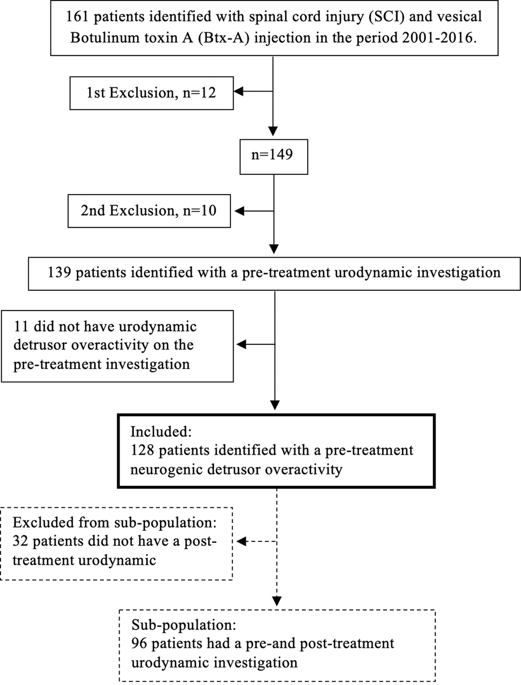Spinal Cord ( IF 2.2 ) Pub Date : 2020-01-08 , DOI: 10.1038/s41393-019-0411-0 Katrine P Hebert 1 , Niels Klarskov 2 , Per Bagi 1 , Fin Biering-Sørensen 3 , Marlene Elmelund 2, 3

|
Study design
Retrospective chart study.
Objectives
The aim was to examine continuation of treatment of individuals with spinal cord injury including myelomeningocele and neurogenic detrusor overactivity, treated with repeated intra-detrusor Botulinum toxin A injections, and to investigate factors associated with discontinuation of treatment.
Setting
Rigshospitalet, Denmark
Methods
This study included 128 individuals with spinal cord injury and neurogenic detrusor overactivity, who were offered repeated Botulinum toxin A injections between 2001 and 2018. Continuation rates of the treatment were estimated using Kaplan Meier analysis. A Cox proportional hazard analysis was used to investigate factors predictive of discontinuation.
Results
A total of 1156 treatments were performed. The median number of treatments was six (IQR 9, range 1−51), and median follow-up was 10.6 years (IQR 8.5, range 0−16.9). All urodynamic parameters changed significantly after the first treatment (p < 0.001). The continuation group had significantly higher mean maximum bladder capacity after the first injections compared with the discontinuation group, with a mean difference between the groups of 84.5 mL (95% CI 4.7–164.2) (p = 0.038). The probability of continuing treatments after 5 years was 59% (95% CI 50.0–67.8) and 50% (95% CI 40.1–59.3) after 10 years. Individuals aged 31–50 years were more likely to continue treatment compared with those aged >50 years (95% CI 0.21‒0.79) (p = 0.008). No other factors predicted discontinuation.
Conclusions
This long-term follow-up study showed that 50% of people with spinal cord injury starting intra-detrusor Botulinum toxin A for neurogenic detrusor overactivity are still receiving injections after 10 years.
中文翻译:

脊髓损伤后神经源性逼尿肌过度活跃的患者长期继续反复注射 A 型肉毒杆菌毒素
学习规划
回顾性图表研究。
目标
目的是检查脊髓损伤患者的继续治疗,包括脊髓脊膜膨出和神经源性逼尿肌过度活动,通过反复逼尿肌内注射肉毒杆菌毒素 A 进行治疗,并调查与停止治疗相关的因素。
环境
Rigshospitalet, 丹麦
方法
这项研究包括 128 名患有脊髓损伤和神经源性逼尿肌过度活动的人,他们在 2001 年至 2018 年期间接受了重复的肉毒杆菌毒素 A 注射。使用 Kaplan Meier 分析估计了治疗的继续率。Cox 比例风险分析用于调查预测停药的因素。
结果
总共进行了1156次治疗。中位治疗次数为 6 次(IQR 9,范围 1-51),中位随访时间为 10.6 年(IQR 8.5,范围 0-16.9)。首次治疗后所有尿动力学参数均发生显着变化(p < 0.001)。与停药组相比,继续组在第一次注射后的平均最大膀胱容量显着高于停药组,两组之间的平均差异为 84.5 mL (95% CI 4.7-164.2) ( p = 0.038)。5 年后继续治疗的概率为 59% (95% CI 50.0–67.8) 和 10 年后 50% (95% CI 40.1–59.3)。与 >50 岁的人相比,31-50 岁的人更有可能继续治疗(95% CI 0.21-0.79)(p = 0.008)。没有其他因素预测停药。
结论
这项长期随访研究表明, 50% 的脊髓损伤患者因神经源性逼尿肌过度活动而开始使用逼尿肌内注射 A 型肉毒杆菌毒素,但 10 年后仍在接受注射。


























 京公网安备 11010802027423号
京公网安备 11010802027423号